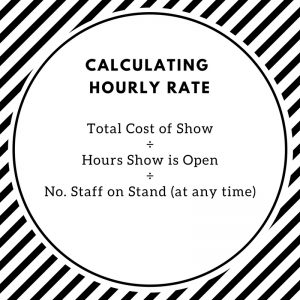Regardless of which camp they fall into, it can be a tiring few days and the added workload to the weeks surrounding can feel a little daunting. In the weeks leading up to the main event everyone’s busy prepping and afterwards they’re re-connecting with contacts from the show to take advantage of the momentum surrounding an exhibition.
Today I’m sharing my top tips for getting the most out of your team at your next exhibition. The following ideas will help reduce the stress associated with exhibitions and keep your A-Team operating like a well-oiled machine. My aim is to get everyone actually enjoying the process too!
Alright, enough of that. Here are the tips:
No late Nights
The days are long and you’re going to be on your feet more than usual. Getting to bed at a reasonable hour, minus a hangover is essential if you’re to effectively operate as a human. It’s show time. Literally!
Keep it Professional
Remind them that even outside of show hours, they are representing the company and it’s possible that people from the show might be at the same bar or restaurant. I’ve heard horror stories of staff going wild and coming face-to-face with people the next day at the trade show. It can be incredibly damaging. At its core, managing staff performance at exhibitions stems from managing staff.
Book the right Accommodation
Yes, it’s an exciting day out for the team when they can get out of their daily routines. You don’t want them chatting away on the stand when they should be selling, but you don’t want them to feel like they’re at boarding school either.
I was recently speaking to someone who missed out on booking a hotel close to the venue. Instead, they chose one much further out and arranged for a mini bus to charter the team in. It worked out cheaper for them but also had a number of other advantages they hadn’t realized at the time. It was a quieter location which had less distractions after the event, the team were able to get their gossip session out of the way before they got to the exhibition and regardless of the weather (heat, cold or rain) they all showed up fresh at the show because they didn’t have to battle a brolly or carry extra coats.
Arrive Early
Give everyone time to familiarise themselves with the stand and complete any finishing touches so they are ready for conversations when doors open. Get to the venue with enough time for them to do a quick fly around the show to quell any interest and limit distractions throughout the show. You don’t want them looking over shoulders at other designs or taking longer than necessary looking for toilets etc.
Set Ground Rules
No answering calls, emails or group chats when you’re on the stand. It’s not what you’re there to do. When you’re on the stand, you’re there to build relationships, connect with visitors, answer questions and of course sell. Sounds obvious, but voicing this with everyone is still important.
Have a Roster
It might not go according to plan all the time, but a roster has many benefits. The biggest advantage is that you’ll avoid distractions. By scheduling down time for each staff member they know there is a designated time for doing everything. They know when they can rest their feet, reply to emails/voicemails and it also lets them see more of the show and switch off. They’ll return from their breaks with better focus and it will really help keep them focused on connecting with visitors. Plus, it also makes sure you don’t break the golden rule of never leaving your stand unattended.
Shout Lunch
Get a healthy lunch delivered to the stand so staff can take it with them on their break and don’t waste break time looking for a feed. I would make sure it’s something that can be set aside and picked up again in case you have an influx of people. Ideally something not too messy. I’ve known people to eat in their storerooms, but ideally you want each member to have a break from the exhibit. Let them have some down time away from the stand.
It’s also not a bad idea to bring along some healthy snacks if anyone gets ravenous. Some nuts or muesli bars are good options that won’t get squashed in transit and are easy to stash in a cupboard. Don’t forget to have lots of water too!
Hygiene is Important
Keep a stash of essentials in a cupboard/storeroom for everyone to access. Don’t make a big deal about it, just let people know it’s there if they need it. Include things like spray deodorant, bandaids and breath mints. A great tip is to affix a cheap little mirror to the inside of a cupboard door in your storeroom (perfect for avoiding an awkward conversation with spinach in your teeth).
Play to your team’s strengths
Assign roles based on their personality traits. It will lessen the stress each member feels because they aren’t trying to be something they’re not. Ideas: Pulling people off the aisles, managing the interactive, demos or more in-depth conversations.
Team work
The aim is to get the team working efficiently as a whole. It doesn’t mean a lead has to stay with the one person. Get your chatterboxes up the front as “hunters” ready to pass anyone who fits your specific criteria to the more detail-oriented guys up the back who can answer questions without worrying about passing traffic.
When everyone knows his or her specialty, the team as a whole will function more efficiently. If you have multiple roles and it’s a long show, consider mixing them up to give the team variety.
Body Language
This topic often gets skimmed over but it’s definitely influential. If someone is overly attentive and puffed up, it’s as intimidating to a visitor as a group of staff chatting away. While you want to be alert, you have to be welcoming. It’s worth discussing it with the team before the show so they can feel confident bringing it up with each other throughout the show. Remind them that they aren’t being nasty by pointing it out. They’re helping each other. Think of it as good practice for cocktail parties!
Time Wasters
A great strategy for moving unwanted visitors who might not be your target audience is redirecting them to other exhibitors. The team will need to know who else is at the show and be able to discuss the other exhibits to do this effectively. Here are some more visitor personalities and strategies for dealing with them and managing staff at exhibitions.
Let them in on the Plan
To maximise your return from a show you want everyone to know what’s at stake. I would go as far as letting them know their hourly rate for the event and break it down into 15min chunks. It does wonders for helping them prioritise their conversations. Use this simple calculation.

True story – A customer once showed up at a tradeshow wanting to discuss some problems they’d experienced. The staff on the stand were talking to themselves and this customer was unattended. He didn’t just leave the stand frustrated, he also took his business elsewhere which cost the business $6M in a lost revenue over the 3 years it took them to win the client back. Moral of this story – You never know who is standing in front of you so treat everyone with respect.
New Feet
Get everyone to pack a change of shoes/socks. When your feet start to fatigue, rotate to your backup pair. Sounds weird, but it works. You’ll feel like you have new feet. Who doesn’t want happy feet?
Set KPI’s
You’re there to further your sales. Don’t just wait to “see how the show is”. The KPI’s you set don’t have to be based on sales or orders. What about the number of demos you do, leads captured or appointments set for after the show? Ultimately everyone wants to generate business but it’s motivating for staff to be able to track their success throughout a show and not have to wait until everything is tallied up after the event.
Make sure everyone has practiced how to use the lead tracker system (whatever method you choose). They need to be confident enough to do it while having a conversation with someone so don’t rush through this step and give everyone a chance to get used to it. Determine how will you track your targets using the system and where you’ll put feedback on for each day?
As you can see, there are a lot of ways to keep your team on-point and most of them are pretty practical ways to manage staff at exhibitions. There are so many ways you can help make the experience more pleasant and organised so your team can all enjoy the experience and feel like they are actively making a difference.
What are some of the things you do in your business to help keep your team on point? Let me know, I’d love to hear what’s working for you!
